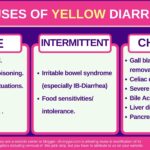Jelly-Like Mucus in Stool: 7 Causes, Gastroenterologist Explains.
Our content is not intended nor recommended as a substitute for medical advice by your doctor. Use for informational purposes only.
The passage of jelly-like mucus in stool often reflects inflammation in the lining of your intestine. Recent onset jelly-like mucus in the stool is usually due to infections (particularly dysentery).
Also, Recurrent or chronic Jelly-like mucus in stool can be due to chronic gastrointestinal diseases such as IBS, IBD, and chronic infections.
Below are the most common causes of jelly-like mucus in stool.
1. Dysentery.
Dysentery is due to infection with either Shigella bacteria (bacillary dysentery) or amoeba (amoebic dysentery).
Dysentery can present with jelly-like mucus in stools (with or without blood).
Symptoms of bacillary dysentery.
- The onset is acute; dysentery is unlikely if you have recurrent mucus poop.
- Intense abdominal pain, especially in the lower abdomen.
- Diarrhea is associated with mucus (jelly-like) with or without blood.
- In severe cases, mucus-only stools. This is because mucus and blood can come out without feces.
- Tenesmus: intense urgency to poop, but only mucus or a small amount of poop comes out.
- Fever: usually high grade.
- Nausea or vomiting (rarely present with bacillary dysentery).
Symptoms of amoebic dysentery are similar to bacilliary dysentery; the main differences are:
- The onset is more gradual (usually over one to three weeks), and the severity is less than bacillary dysentery.
- It can range from mild diarrhea to severe dysentery with mucus and blood in the stool.
- Abdominal pain and fever are milder.
- Tenesmus is moderate.
- The stool is usually more formed and bulky; blood and mucus are mixed with feces (with bacillary dysentery, blood, and mucus come out without feces).
- In severe cases, Entamoeba organisms can invade the colon wall, cause intestinal perforation, and cause fulminant inflammation of the colon.
2. Other gut infections and foodborne illnesses.
Some other organisms can cause jelly-like mucus in your stool (ref):
- Salmonella (typhoid fever).
- E. coli (Shiga toxin-producing, Entero-invasive E. coli).
- Clostridium Difficile.
- Cytomegalovirus colitis.
- And other less common organisms.
The above organisms can cause dysentery with jelly-like mucus and blood in the stool. Symptoms may vary from mild to severe and persistent illness.
The acute onset and presence of intense abdominal pain and fever are suggestive of infectious diarrhea and dysentery.
3. IBS
Another common cause of abdominal pain and loose yellow stool is Irritable bowel syndrome.
IBS affects around 11 to 15% of the population (ref). Although there is currently no reliable test to diagnose IBS, IBS is interpreted according to some clinical criteria.
The fundamental symptom of IBS is abdominal pain that occurs at least once per week. The onset of abdominal pain is associated with at least 2 of the following:
- Defecation: abdominal pain is relieved (or worsened) during or after defecation.
- Change in stool form: stool becomes more hard or loose (and yellow).
- Change in stool frequency: more frequent or less frequent bowel movements (constipation or diarrhea)
Only 30% of people matching the IBS criteria will consult their doctors about IBS symptoms (ref).
This leaves 70% of people matching the diagnostic criteria of IBS without even knowing they’ve IBS!
If you have recurrent abdominal pain and yellow stool, Read this in-depth guide to determine if you have IBS.
Mucus In Stool With IBS: Causes, Different Colors, & Treatment.
4. IBD
Inflammatory bowel disease refers to 2 major conditions:
- Crohn’s disease: Unexplained inflammation and ulceration at any part of your gut (from the mouth to the anus).
- Ulcerative colitis: Unexplained inflammation and ulceration affecting the large intestine only (the colon and the rectum).
According to the CDC, about 1.8 million U.S. adults (0.9%) had inflammatory bowel disease.
Symptoms of IBD:
- Persistent or recurrent diarrhea.
- Abdominal pain.
- Blood or blood and mucus coming out with or without a stool.
- Weight loss.
- Generalized fatigue.
- Fever may occur.
- Loss of appetite.
Suspect IBD if you have a prolonged history of abdominal pain, mucus, constant diarrhea, and blood in stool without obvious cause.
The main differences between Crohn’s and ulcerative colitis are summarized in the below table.
| Type | Crohn’s Disease | Ulcerative Colitis |
| 1- Site | Any part of the GI tract (from the mouth to the anus) | The colon and rectum. |
| 2- Lesions | Deeper, it can involve all the layers of the GI wall. | Usually superficial (only in the innermost layer) |
| 3-Predominant symptom | Crampy abdominal pain | Bloody diarrhea. (can be constant) |
| 4- Complications | Fistulas, abscess, intestinal obstruction | hemorrhagic toxic megacolon. |
| 5- Risk of colon cancer | Slight increase | Marked increase |
Ulcerative colitis and Crohn’s disease are major diseases that require medical care and follow-up.
Consult your doctor if you have a long history of recurrent abdominal pain and constant diarrhea with blood and mucus in stool.
5. STD.
Recent sexual practice involving the anal or rectal area followed by rectal discharge (mucus only coming out with urgency) may indicate a sexually transmitted disease.
Having anal sex activity with an infected partner can lead to severe proctitis.
Unfortunately, Your partner doesn’t have to be symptomatic to transmit the infection to you.
Common causes of STD-causing proctitis:
- Anorectal gonorrhea.
- Chlamydia infection: chlamydia infection of the anal canal and the rectum commonly causes a severe urge to poop, and only mucus comes out.
- Syphilis: causes painful ulcers in the anal canal and the rectum with the discharge of pus and mucus.
- Sexually transmitted campylobacter Jejuni: causes rectal ulcer, mucus-only diarrhea, intense urgency, and abdominal cramps.
Symptoms of STDs as a cause of proctitis:
- Anal pain.
- Tenesmus: a sense of complete evacuation of the rectum after defecation.
- Recent history of anal sex activities (even with a partner without symptoms).
- Urgency: the sudden and intense urge to poop.
- Frequency: frequent attacks of stool urgency with nothing coming out or only mucus or pus.
- Rectal discharge: pus, mucus, blood, or mixed discharge.
- Fever may occur.
- Other genital symptoms, such as ulcers or abnormal discharge, may also be present.
Consult your doctor or an STD specialist immediately if you suspect you have an STD.
6. Inflammed hemorrhoids and anal fissures.
Fissures commonly occur due to:
- Chronic constipation.
- Normal delivery in females.
- Local trauma of the anus.
- Chronic inflammatory diseases of the anus, such as Crohn’s disease or anal or rectal cancer.
Symptoms of anal fissures:
- Severe anal or rectal pain increases while poop is the main symptom. Almost there is no fissure without sharp pain.
- History of the causes, such as severe constipation or local trauma to the anus.
- With chronic fissures, you may feel a skin tag at the opening of your anal canal.
Inflamed Hemorrhoids (piles):
Hemorrhoids are dilated inflamed veins in the wall of the anal canal. Inflamed hemorrhoids can irritate the canal and secrete mucus.
Mucus from the inflamed hemorrhoids can come out without stool. It is associated with the urge to poop even after having a bowel movement (ref).
A bulge or a skin tag may be felt at the opening of the anus. Whether you are diagnosed with hemorrhoids before or not, you must see your doctor if you’re pooping only mucus with the hemorrhoids.
7. Other causes of anorectal inflammation.
- Anal and colorectal cancers.
- Rectal ulcer.
- Diversion colitis.
- Antibiotic-associated colitis.
- Intestinal obstruction.
- Radiation therapy.
- Eosinophilic proctitis.
- Severe forms of food intolerance and food allergy.
- Anal fistulas or sinus.
- Evidence-based
- Written by a doctor.

Related Posts:
- Mucus In Stool With IBS: Causes, Different Colors, &…
- Pooping mucus only: 12 Causes Explained (Dr. Farahat).
- Can Stress Cause Appendicitis? Gastroenterologist Explains.
- When to worry about ALT levels? Gastroenterologist Explains.
- Untreated Pancreatitis: 6 Possible Scenarios…
- Stabbing Chest Pain When Swallowing: 5 Causes,…





